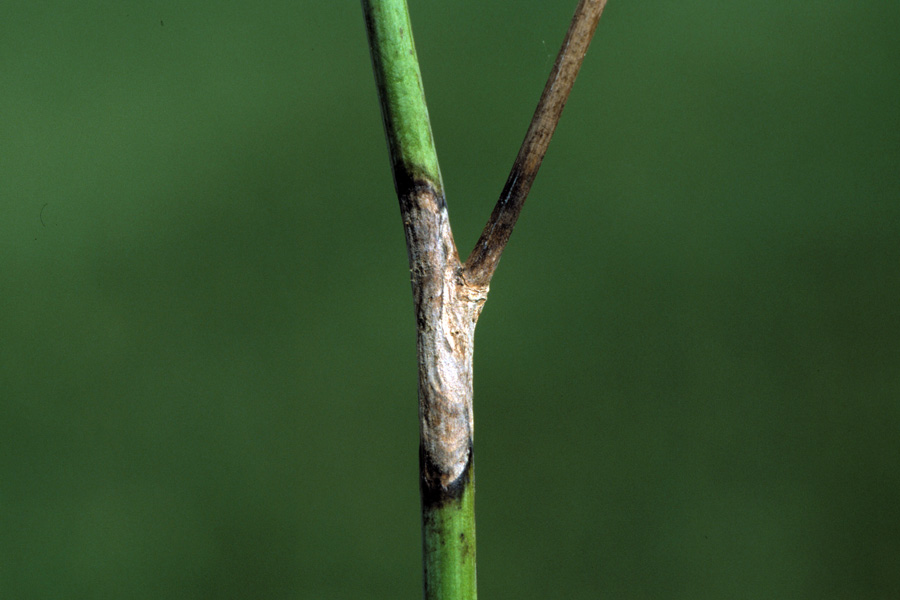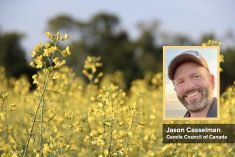It’s pretty much impossible to say in advance exactly what crop diseases are going to be present in your fields this coming season — but you can still have a solid idea of what to look for when the time comes.
That’s because crop diseases are greatly influenced by weather and history, and when these factors start lining up, it’s time to start looking.
When forecasting the potential for crop disease, plant pathologists use what they refer to as a “disease triangle.” Side number one: Is the pathogen expected to be there? Was it there in recent years, or was it there last time the crop was grown? Side number two: What crop is the farmer growing? What variety is it? What disease(s) is it susceptible to, and does it have any disease resistance?
Read Also

Could crop sharing be a viable option for your farm?
Crop sharing could be a good option for young and beginning farmers.
The third and perhaps most important side is what the weather is going to be like, says Faye Dokken-Bouchard, Saskatchewan Agriculture’s plant disease specialist. Most plant diseases favour moist conditions, so when there’s a year with excess rainfall, particularly during the crop’s most susceptible growing stage, it raises the likelihood of disease.
Dokken-Bouchard adds when it comes to the crop itself, tight rotations are another consideration, as the practice heightens disease outbreak risks.
“That’s why crop rotation is the cornerstone of integrated pest management strategy,” she says. “The choice of what crop you grow is what will determine what host you have present, and how frequently you grew it in the past will determine how much disease inoculum will be present. If you’ve grown a lot of the same crop a number of years, either in a row or with short breaks in between — especially if you had a lot of disease incidents that you were aware of in those years — then you know there’s more disease inoculum likely to be present.”
Even if disease issues weren’t present or were at low levels, every time that same crop is grown, the disease inoculum builds.
One relief for Saskatchewan farmers is that 2013 wasn’t a huge disease year, mostly because the moisture received arrived in a timely fashion conducive for crop growth, not disease development. Disease prevention management also contributed to outbreak suppression.
While there may be a reduction in disease inoculum contributed from 2013, there was quite a bit of disease in 2012, which could still carry over. In 2012, 91 per cent of the canola crops surveyed had sclerotinia, and sclerotinia can last in the soil for around five years, says Dokken-Bouchard.
“It’s good news there wasn’t as much disease last year, but it doesn’t totally preclude the opportunity for having more disease issues,” Dokken-Bouchard says.
Blackleg is another disease to watch for in canola, with levels rising in recent years.
Cereal producers are also well aware of fusarium head blight (FHB), which is widespread and can become problematic in years when wet conditions arrive during flowering. Moisture during harvest can also become an issue for seed quality: not head blight-damaged kernels, but the growth of fusarium on the seed, which downgrades its quality, Dokken-Bouchard says.
Ergot has risen every year, mainly because zero and no till mean the ergot bodies may not be getting buried deep enough, so they’re closer to the surface and able to produce spores.
If Saskatchewan farmers growing pulses have experienced ascochyta, anthracnose or sclerotinia in recent years, they should allow for a longer rotation to allow those diseases to break down before growing that crop again, Dokken-Bouchard recommends.
In Alberta, there seems to be more potential for disease. Residue-borne diseases on cereal crops, such as leaf spot disease and FHB, have been significant for three or more years in a row in some cases, and disease pressure continues building, says provincial plant pathologist Mike Harding. Ergot also is building and getting worse each year.
From the Grainews website: Six ways to reduce early season seed stress
Many areas of Alberta have also experienced saturated spring conditions three years in a row, which has been conducive for clubroot to get established, cause infections and spread. The province had a record number of new confirmed cases of clubroot in 2013.
Sclerotinia is routinely observed in the province and is almost exclusively weather-driven — and it’s probably going to be a significant player again in 2014, Harding believes.
Blackleg in canola is another concern, especially with crop rotations likely becoming tighter this year. “It’s certainly a case where we’ve had probably higher-than-normal disease levels for a couple years, maybe even three in a row in many parts of the province. That indicates if we have conducive weather in 2014, there could again be lots of disease problems,” says Harding.
Farmers should be scouting and scouting early for any of the diseases that could possibly show up. Harding, however, cautions against fungicide application unless economically beneficial.
“Fungicides are definitely an important tool for a lot of these diseases, but fungicides will only really provide an economic benefit when there’s yield potential being threatened by a significant disease potential,” Harding says.
Fungicide timing is also critical, and spraying too early or late will undermine any potential economic return.
“Scout your crops and watch for the condition where you’ve got yield potential and disease potential, and then get that fungicide on during the application window that’s going to protect your crop against the yield loss,” Harding says.
Rotation of fungicides is also important, as are the rotations of both crops and crop genetics, says Manitoba Agriculture plant pathologist Vikram Bisht.
Manitoba disease pressure was below normal in 2013 in most cases, but farmers didn’t escape completely, and there may be carry-over issues this spring.
Higher levels of ergot downgraded wheat samples in southwest Manitoba, which received 150 per cent of typical rainfall levels. “And (ergot) seems to be trending upwards,” says Bisht.
Ergot incidence this year will greatly depend upon the mid-season rain distribution.
FHB wasn’t significant last year and in some cases was lower than normal. But with corn acres trending higher every year, there’s a possibility of higher levels of FHB showing up in small-grain cereals, as ear rot in corn is caused by the same fusarium species that causes FHB in wheat.
“It can be basically a combination of two crops increasing the disease,” says Bisht, who believes FHB in wheat and other cereals could become a more serious issue.
Besides scouting — an early warning system Bisht urges farmers undertake for all their crops — producers should make use of Manitoba Ag’s forecast reports to help monitor for FHB risk and prepare for timely fungicide application.
Further on corn, Goss’s wilt and leaf blight disease has been increasing. It’s a bacterial disease that can survive very well in the soil and has spread rapidly in the province. Only one field was found in 2009, but by 2011, 83 per cent of fields surveyed showed the disease. It’s even more widespread now: “It is now an endemic problem for us,” says Bisht.
As a bacterial disease, no fungicide is effective against it, but there are a few varieties that are tolerant.
Besides corn, another crop growing in popularity is soybeans, and as the industry asks itself how to get to two million planted acres, crop rotation concerns become heightened.
“The crop is probably not going to stay a Cinderella crop anymore. It will get more diseases,” says Bisht.
Even when soybeans are grown in rotation with canola, sunflowers or beans, sclerotinia disease/white mould can still become an issue because sclerotinia can infect all those crops and produce sclerotinia for the following season.
Outside soybean seed can introduce disease too, as seeds can carry disease from one region to another. Another issue is Phytophthora stem and root rot, which was more prevalent in soybeans in 2013 than 2012 and will remain an ongoing concern.
Soybean cyst nematode isn’t problematic yet, but with the deregulation of federal prevention controls of the pest, Bisht wonders how long it’ll take before the cysts appear in Manitoba crops. It’s present south of the border, and there’s a risk of water dispersal into Manitoba.
In canola, blackleg incidents have been rising since 2007, in spite of many resistant varieties, as the fungus changes in response to high selection pressure and very tight crop rotations.
Clubroot reared its head in 2013, with infected plants found in two fields and six fields testing positive for clubroot pathogen DNA. While extremely low compared to Alberta, where over 400 new fields with infected plants were identified, Bisht urges farmers to be extremely vigilant in preventing the disease from becoming more widespread. The disease spreads with soil-laden equipment moved from one field to another.
Unexpectedly, wheat streak mosaic also had an impact on canola. How? In the past, some winter wheat growers who experienced poor survival cultivated their fields and planted spring wheat. But when some of those winter wheat seedlings survived, mites were able to spread the disease from infected winter wheat to spring. And when the spring wheat didn’t do well, it too was cultivated, and canola planted in its place. And in some cases, that resulted in back-to-back canola.
“And so some of the canola had various kinds of root maggots and very high levels of blackleg disease, the combination of which reduce production,” says Bisht, adding other disease too can emerge in such cases because of the consecutive canola seedings.
















